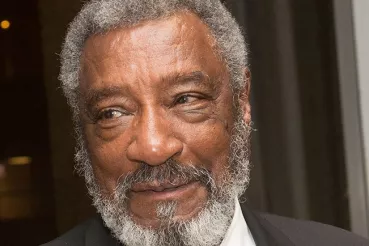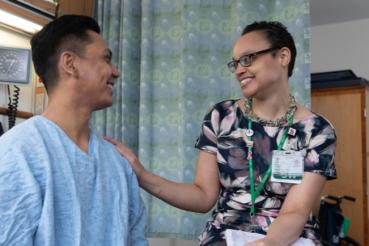Rukiya Curvey Johnson learned early on that local institutions play a fundamental role in strengthening their communities. The church her family attended while she was growing up in Houston, Texas, made a particularly big impression.
“They were focused on working with residents to take more ownership in their neighborhood, to be more politically involved and to have a say in how their city was run,” Curvey Johnson said. “That commitment spoke to me even when I was a kid; ever since, I’ve been involved in the community in some form or fashion.”
Curvey Johnson joined Rush University System for Health in 2017 to establish and lead the Rush Education and Career Hub, or REACH for short. Now, as Rush University Medical Center's interim vice president of community health equity, she leads Rush's work to improve health equity on Chicago's West Side.
Striving for equity in education
Equity has been Curvey Johnson's passion for years. Before joining Rush, she spent nearly 10 years leading educational equity work in Chicago Public Schools. “Part of my role was working with principals to make sure their students were ready to learn,” she said.
“That meant addressing questions like did they have enough food, did they have their vaccinations, did they need housing assistance, did their parents need employment assistance? All those things that happen outside the classroom have a big impact on educational attainment.”
At Rush, Curvey Johnson used that experience to transform the Science and Math Education (SAME) Network into REACH, which offers pipeline programming designed to engage Black, Latinx and other underrepresented young people in STEM and health care careers. Over the last five years, REACH programming and supports have helped 100% of participating students return to their college for their second year.
In 2020, Curvey Johnson was asked to lead the work of Department of Community Health and Engagement and its efforts to address the social determinants of health — the non-medical factors that lead to adverse health conditions — on the West Side.
“Rukiya brings years of experience to this role, particularly in the area of educational and career pathways that lead to wealth creation,” said David A. Ansell, MD, MPH, senior vice president for community health equity and associate provost for community affairs. “The REACH program, which she designed and led, is nationally recognized as a groundbreaking STEM program. “
Closing equity gaps
The social determinants of health include systemic racism, poverty, inadequate education and housing, food insecurity and insecure employment — factors that are largely responsible for the 16-year life expectancy gap between people living in the West Garfield Park neighborhood, where people live on average to age 69, and the Loop, where the life expectancy is 85.
For many West Side residents, the COVID-19 pandemic only increased equity gaps. Curvey Johnson and her team took on the task of meeting the immediate needs of a struggling community, while thinking strategically down the line to meet long-term challenges.
Since the pandemic began, the CHEE team has provided boxes of fresh, healthy food to more than 20,000 people on the West Side. And its community health worker team has grown to include nearly 40 frontline public health workers who connect people with health care and social services.
“COVID has certainly exacerbated problems,” she said. “Our focus has been sourcing enough food, making sure we have enough people to do outreach, making sure we have enough funding to meet all our needs.
"Really, how do we position ourselves to create a responsive task force — who can work on vaccine outreach, health equity initiatives, pipeline programs and community development collaborations?”
The long view: improving health outcomes
Over the long term, Curvey Johnson believes that Rush and CHEE are uniquely positioned to improve health outcomes on the West Side in a number of ways.
For example, community health workers can help people successfully manage chronic health conditions like diabetes and hypertension by coordinating traditional and non-traditional modes of care with health care providers and community partners.
“That’s where we can continue to shine, through our work with the population health team,” she said. “I also see a big part of my role as developing alignment and collaboration across the Rush system. We can share best practices and inform the approach for community health equity at Rush Oak Park and Rush Copley.”
Curvey Johnson also has her eye on continuing to boost educational advancement through REACH, with the goal of building a more diverse workforce in the STEM and health care fields.
Educational attainment beyond high school is a key predictor of longer life spans and better health outcomes, she explains, and a diverse health care workforce results in higher-quality care for a diverse patient population.
“As an academic medical center, I think we’re well situated to go beyond doing the usual career day for kids interested in being doctors and nurses,” she said.
“Our cradle-to-career pipeline programs spark interest in a broad range of STEM and health care careers, and strengthen the academic and workplace skills that students need for access and success in higher education and careers.”
As rates of COVID-19 infections and hospitalizations continue to decline, Curvey Johnson plans to focus on new opportunities to engage Rush allies and partners to improve community health and vitality.
“There’s so much to do, and we’ve been blessed with this amazing and committed staff,” she said. “We take a breath, but we keep going.”




